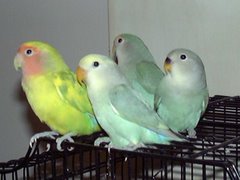Microchipping - a Perfect method for lovebird Identification
 Most of the lovebirds owners find difficult to identify each and every bird, if they are maintaining more than 10 birds of same variety and color. Hence it is mandatory to do microchipping of your lovebirds.
Most of the lovebirds owners find difficult to identify each and every bird, if they are maintaining more than 10 birds of same variety and color. Hence it is mandatory to do microchipping of your lovebirds.
This method is helpful to identify your lovebird in case of escape or loss. Your avian vet will inject a custom microchip under the skin. Microchipping is the safe method of lovebirds identification. Within few seconds, your vet can implant the microchip under the skin of the lovebird.
Why Microchipping?
This is the only permanent way to prove that the lovebird is yours in case of theft or escape. This is the safest method of bird identification with no stress on the bird. In addition, it can be implanted within the bird without undue stress to the same. But with a microchip you can prove the bird is yours.
Advantages
This micro chip never move within the body. Earlier chips are having problem of migration which causes stress for the birds. This chip is of rice grain in shape and encourage to form a scar tissue around it, thus anchoring them into place. The chip has an average life of around 25+ years
AVID and HomeAgain are the two companies that made microchipping for lovebirds. AVID providing common scanners used in pet birds.
So, do microchip your lovebirds to get identified easily. ALL THE BEST!!!


2 comments:
Hi,
Thank you for your very interesting post about lovebird microchipping. As your post is the only one i've seen online regarding microchipping lovebirds, I have a few questions:
Does the bird bleed when the microchip is put in?
Where is the microchip placed on the bird?
Do you have any more information concerning the AVID and
HomeAgain microchips? I've been on their websites but they only talk about cats and dogs.
thanks,
Tinka
Microchipping provides a permanent and unique way of identifying a lovebird. The microchip can be inserted into the pectoral muscle tissue of birds. Birds won't bleed when you microchip them. If you notice a hole left by the needle at the insertion point, this can be repaired by tissue glue or suture
Ref:
Siegal-Willcott, J., Heard, D., Sliess, N., Naydan, D., & Roberts, J., (2007) Microchip associated leiomyosarcoma in an african fruit bat (Rousettus aegptiacus). J Zool. Wildl. Med. 38, 352-356
Post a Comment